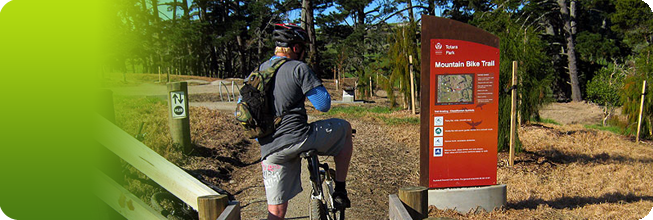Kauri Dieback - an important message for all
You need to help save this awesome tree
- Kauri Dieback Fact Sheet (PDF 209kb)
- Kauri Dieback Flyer (PDF 170kb)
- Kauri Dieback ID Field Guide (PDF 823kb)
- The Science Behind PTA (PDF 332kb)
 What can we do to stop it spreading?
What can we do to stop it spreading?
- Make sure shoes, tyres and equipment are clean of dirt before and after visiting kauri forest
- Use the new bike washdown facility at the carpark of the Hunua Moumoukai Valley MTB Trails.
- Clean shoes and any other equipment that comes into contact with soil after every visit, especially if moving between bush areas
- Keep to defined park tracks at all times. Any movement of soil around the roots of a tree has the potential to spread the disease
- Keep your dog on a leash at all times. Dogs can inadvertently spread the disease if they disturb the soil around the trees
Kauri dieback: how you can help
Article courtesy of the ARC website for fighting Kauri Dieback: www.kauridieback.co.nz
This webpage is the home for information on kauri dieback for the whole of New Zealand. It has information on what kauri dieback is, the symptoms of the disease and how you can help stop it spreading. You can also find our fact sheet, technical documents and links to the organisations involved in the management of the disease.
What is Phytophthora taxon Agathis?
Commonly known as PTA, Phytophthora taxon Agathis is a microscopic fungus-like plant pathogen (a disease causing agent) that only affects kauri. Recent research has identified PTA as a distinct and previously undescribed species of Phytophthora.
What does it do to kauri trees?
Symptoms include yellowing of foliage, loss of leaves, canopy thinning and dead branches. Affected trees can also develop lesions that bleed resin, extending to the major roots and sometimes girdling the trunk as a ‘collar rot'. PTA can kill trees and seedlings of all ages.
| | |
| |
How is it spread?
PTA is believed to be a soil-borne species spread by soil and soil water movement, plant to plant transmission through underground root-to-root contact, and human and animal vectors.
Where did it come from?
Formally identified in April 2008, its closest known relative is a chestnut pathogen from Korea (Phytophthora katsurae). The assumption is that it is an exotic pathogen. However nothing is known about this particular species overseas.
Where is it?
PTA has been found at Huia, Cascade Kauri and Maungaroa Ridge in the Waitakere Ranges Regional Park and at Department of Conservation reserves at Pakiri, Great Barrier, Trounson Kauri Park and Waipoua Forest in Northland.
Symptoms of kauri dieback have also been observed at other sites in Rodney, Franklin, Waitakere and the North Shore, as well as Albany, Okura and Northland.
What can we do to stop it spreading?
- Make sure shoes, tyres and equipment are clean of dirt before and after visiting kauri forest
- Clean shoes and any other equipment that comes into contact with soil after every visit, especially if moving between bush areas
- Keep to defined park tracks at all times. Any movement of soil around the roots of a tree has the potential to spread the disease
- Keep your dog on a leash at all times. Dogs can inadvertently spread the disease if they disturb the soil around the trees
What should I do if I have kauri on my land?
- Minimise movement around kauri tree roots
- Keep dogs and animals away from kauri trees
- Download this warning sign and put it up to alert visitors to the dangers of spreading the disease. This can be laminated to make it more durable, or for a durable corflute sign please contact the Kauri Dieback Management Team on 0800 NZ KAURI (69 52874).
- If you think your trees have PTA symptoms contact the Kauri Dieback Management Team on 0800 NZ KAURI (69 52874).
Will parks or reserves be closed?
At this stage there are no plans to close entire parks or reserves, however, there will be times when tracks are temporarily closed while re-routing or other work takes place to significantly reduce the chance of spread of kauri dieback. Information about current trrack work is posted below:
Three tracks are temporarily closed in the Waitakere Ranges Regional Park on a trial basis. Visit the ARC parks page for more information or read the press release.
What is being done?
The current programme of work includes:
- Research that improves knowledge of how to detect kauri dieback (sampling and diagnostic techniques)
- Research that shows what spreads the disease and how
- Development of an effective control method (treatment)
- Surveillance that determines whether the disease is present and selected sites, and mapping to show spread
- Assessing the risk posed by the organism to individual trees and their ecosystem
- Public education and provision of appropriate cleaning tools at high risk sites
- Ensuring a co-ordinated approach to Phytophthora taxon Agathis including the appropriate management of communications and information
Contact us
For more information, or to report any suspect sightings of diseased kauri on public or private land, phone the Kauri Dieback Management Team on 0800 NZ KAURI (69 52874)
 | ||
 |  |  |
